Haibo Yang
Exploring Pose-Guided Imitation Learning for Robotic Precise Insertion
May 14, 2025Abstract:Recent studies have proved that imitation learning shows strong potential in the field of robotic manipulation. However, existing methods still struggle with precision manipulation task and rely on inefficient image/point cloud observations. In this paper, we explore to introduce SE(3) object pose into imitation learning and propose the pose-guided efficient imitation learning methods for robotic precise insertion task. First, we propose a precise insertion diffusion policy which utilizes the relative SE(3) pose as the observation-action pair. The policy models the source object SE(3) pose trajectory relative to the target object. Second, we explore to introduce the RGBD data to the pose-guided diffusion policy. Specifically, we design a goal-conditioned RGBD encoder to capture the discrepancy between the current state and the goal state. In addition, a pose-guided residual gated fusion method is proposed, which takes pose features as the backbone, and the RGBD features selectively compensate for pose feature deficiencies through an adaptive gating mechanism. Our methods are evaluated on 6 robotic precise insertion tasks, demonstrating competitive performance with only 7-10 demonstrations. Experiments demonstrate that the proposed methods can successfully complete precision insertion tasks with a clearance of about 0.01 mm. Experimental results highlight its superior efficiency and generalization capability compared to existing baselines. Code will be available at https://github.com/sunhan1997/PoseInsert.
From Interpretation to Correction: A Decentralized Optimization Framework for Exact Convergence in Federated Learning
Mar 25, 2025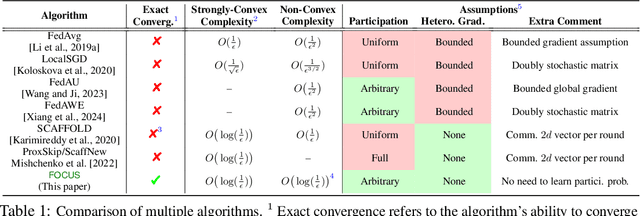


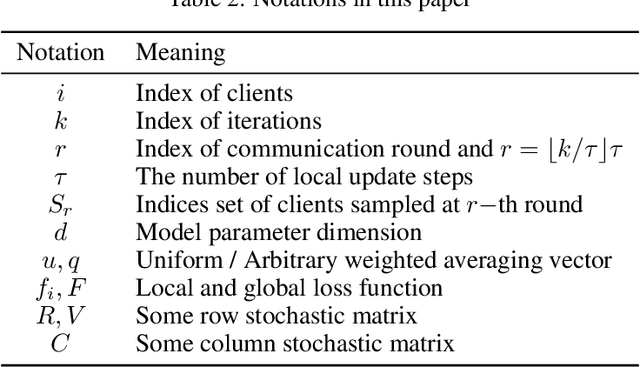
Abstract:This work introduces a novel decentralized framework to interpret federated learning (FL) and, consequently, correct the biases introduced by arbitrary client participation and data heterogeneity, which are two typical traits in practical FL. Specifically, we first reformulate the core processes of FedAvg - client participation, local updating, and model aggregation - as stochastic matrix multiplications. This reformulation allows us to interpret FedAvg as a decentralized algorithm. Leveraging the decentralized optimization framework, we are able to provide a concise analysis to quantify the impact of arbitrary client participation and data heterogeneity on FedAvg's convergence point. This insight motivates the development of Federated Optimization with Exact Convergence via Push-pull Strategy (FOCUS), a novel algorithm inspired by the decentralized algorithm that eliminates these biases and achieves exact convergence without requiring the bounded heterogeneity assumption. Furthermore, we theoretically prove that FOCUS exhibits linear convergence (exponential decay) for both strongly convex and non-convex functions satisfying the Polyak-Lojasiewicz condition, regardless of the arbitrary nature of client participation.
Do We Really Need to Design New Byzantine-robust Aggregation Rules?
Jan 29, 2025



Abstract:Federated learning (FL) allows multiple clients to collaboratively train a global machine learning model through a server, without exchanging their private training data. However, the decentralized aspect of FL makes it susceptible to poisoning attacks, where malicious clients can manipulate the global model by sending altered local model updates. To counter these attacks, a variety of aggregation rules designed to be resilient to Byzantine failures have been introduced. Nonetheless, these methods can still be vulnerable to sophisticated attacks or depend on unrealistic assumptions about the server. In this paper, we demonstrate that there is no need to design new Byzantine-robust aggregation rules; instead, FL can be secured by enhancing the robustness of well-established aggregation rules. To this end, we present FoundationFL, a novel defense mechanism against poisoning attacks. FoundationFL involves the server generating synthetic updates after receiving local model updates from clients. It then applies existing Byzantine-robust foundational aggregation rules, such as Trimmed-mean or Median, to combine clients' model updates with the synthetic ones. We theoretically establish the convergence performance of FoundationFL under Byzantine settings. Comprehensive experiments across several real-world datasets validate the efficiency of our FoundationFL method.
PSMGD: Periodic Stochastic Multi-Gradient Descent for Fast Multi-Objective Optimization
Dec 17, 2024Abstract:Multi-objective optimization (MOO) lies at the core of many machine learning (ML) applications that involve multiple, potentially conflicting objectives (e.g., multi-task learning, multi-objective reinforcement learning, among many others). Despite the long history of MOO, recent years have witnessed a surge in interest within the ML community in the development of gradient manipulation algorithms for MOO, thanks to the availability of gradient information in many ML problems. However, existing gradient manipulation methods for MOO often suffer from long training times, primarily due to the need for computing dynamic weights by solving an additional optimization problem to determine a common descent direction that can decrease all objectives simultaneously. To address this challenge, we propose a new and efficient algorithm called Periodic Stochastic Multi-Gradient Descent (PSMGD) to accelerate MOO. PSMGD is motivated by the key observation that dynamic weights across objectives exhibit small changes under minor updates over short intervals during the optimization process. Consequently, our PSMGD algorithm is designed to periodically compute these dynamic weights and utilizes them repeatedly, thereby effectively reducing the computational overload. Theoretically, we prove that PSMGD can achieve state-of-the-art convergence rates for strongly-convex, general convex, and non-convex functions. Additionally, we introduce a new computational complexity measure, termed backpropagation complexity, and demonstrate that PSMGD could achieve an objective-independent backpropagation complexity. Through extensive experiments, we verify that PSMGD can provide comparable or superior performance to state-of-the-art MOO algorithms while significantly reducing training time.
Hi3D: Pursuing High-Resolution Image-to-3D Generation with Video Diffusion Models
Sep 11, 2024Abstract:Despite having tremendous progress in image-to-3D generation, existing methods still struggle to produce multi-view consistent images with high-resolution textures in detail, especially in the paradigm of 2D diffusion that lacks 3D awareness. In this work, we present High-resolution Image-to-3D model (Hi3D), a new video diffusion based paradigm that redefines a single image to multi-view images as 3D-aware sequential image generation (i.e., orbital video generation). This methodology delves into the underlying temporal consistency knowledge in video diffusion model that generalizes well to geometry consistency across multiple views in 3D generation. Technically, Hi3D first empowers the pre-trained video diffusion model with 3D-aware prior (camera pose condition), yielding multi-view images with low-resolution texture details. A 3D-aware video-to-video refiner is learnt to further scale up the multi-view images with high-resolution texture details. Such high-resolution multi-view images are further augmented with novel views through 3D Gaussian Splatting, which are finally leveraged to obtain high-fidelity meshes via 3D reconstruction. Extensive experiments on both novel view synthesis and single view reconstruction demonstrate that our Hi3D manages to produce superior multi-view consistency images with highly-detailed textures. Source code and data are available at \url{https://github.com/yanghb22-fdu/Hi3D-Official}.
DreamMesh: Jointly Manipulating and Texturing Triangle Meshes for Text-to-3D Generation
Sep 11, 2024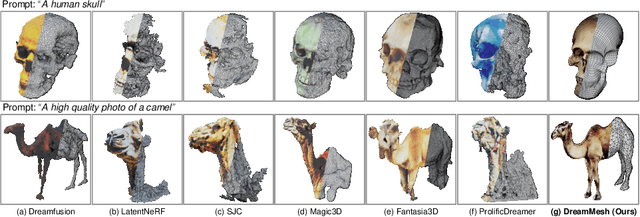



Abstract:Learning radiance fields (NeRF) with powerful 2D diffusion models has garnered popularity for text-to-3D generation. Nevertheless, the implicit 3D representations of NeRF lack explicit modeling of meshes and textures over surfaces, and such surface-undefined way may suffer from the issues, e.g., noisy surfaces with ambiguous texture details or cross-view inconsistency. To alleviate this, we present DreamMesh, a novel text-to-3D architecture that pivots on well-defined surfaces (triangle meshes) to generate high-fidelity explicit 3D model. Technically, DreamMesh capitalizes on a distinctive coarse-to-fine scheme. In the coarse stage, the mesh is first deformed by text-guided Jacobians and then DreamMesh textures the mesh with an interlaced use of 2D diffusion models in a tuning free manner from multiple viewpoints. In the fine stage, DreamMesh jointly manipulates the mesh and refines the texture map, leading to high-quality triangle meshes with high-fidelity textured materials. Extensive experiments demonstrate that DreamMesh significantly outperforms state-of-the-art text-to-3D methods in faithfully generating 3D content with richer textual details and enhanced geometry. Our project page is available at https://dreammesh.github.io.
Adversarial Attacks to Multi-Modal Models
Sep 10, 2024



Abstract:Multi-modal models have gained significant attention due to their powerful capabilities. These models effectively align embeddings across diverse data modalities, showcasing superior performance in downstream tasks compared to their unimodal counterparts. Recent study showed that the attacker can manipulate an image or audio file by altering it in such a way that its embedding matches that of an attacker-chosen targeted input, thereby deceiving downstream models. However, this method often underperforms due to inherent disparities in data from different modalities. In this paper, we introduce CrossFire, an innovative approach to attack multi-modal models. CrossFire begins by transforming the targeted input chosen by the attacker into a format that matches the modality of the original image or audio file. We then formulate our attack as an optimization problem, aiming to minimize the angular deviation between the embeddings of the transformed input and the modified image or audio file. Solving this problem determines the perturbations to be added to the original media. Our extensive experiments on six real-world benchmark datasets reveal that CrossFire can significantly manipulate downstream tasks, surpassing existing attacks. Additionally, we evaluate six defensive strategies against CrossFire, finding that current defenses are insufficient to counteract our CrossFire.
Can We Theoretically Quantify the Impacts of Local Updates on the Generalization Performance of Federated Learning?
Sep 05, 2024



Abstract:Federated Learning (FL) has gained significant popularity due to its effectiveness in training machine learning models across diverse sites without requiring direct data sharing. While various algorithms along with their optimization analyses have shown that FL with local updates is a communication-efficient distributed learning framework, the generalization performance of FL with local updates has received comparatively less attention. This lack of investigation can be attributed to the complex interplay between data heterogeneity and infrequent communication due to the local updates within the FL framework. This motivates us to investigate a fundamental question in FL: Can we quantify the impact of data heterogeneity and local updates on the generalization performance for FL as the learning process evolves? To this end, we conduct a comprehensive theoretical study of FL's generalization performance using a linear model as the first step, where the data heterogeneity is considered for both the stationary and online/non-stationary cases. By providing closed-form expressions of the model error, we rigorously quantify the impact of the number of the local updates (denoted as $K$) under three settings ($K=1$, $K<\infty$, and $K=\infty$) and show how the generalization performance evolves with the number of rounds $t$. Our investigation also provides a comprehensive understanding of how different configurations (including the number of model parameters $p$ and the number of training samples $n$) contribute to the overall generalization performance, thus shedding new insights (such as benign overfitting) for implementing FL over networks.
Achieving Dimension-Free Communication in Federated Learning via Zeroth-Order Optimization
May 24, 2024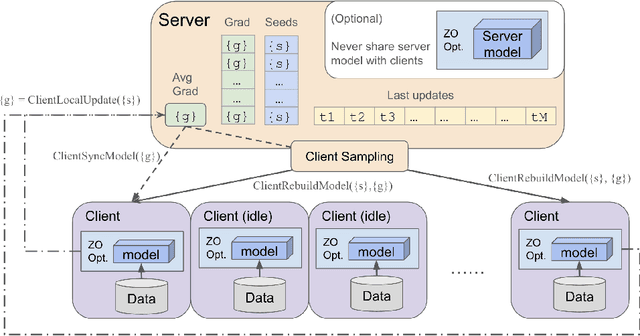



Abstract:Federated Learning (FL) offers a promising framework for collaborative and privacy-preserving machine learning across distributed data sources. However, the substantial communication costs associated with FL pose a significant challenge to its efficiency. Specifically, in each communication round, the communication costs scale linearly with the model's dimension, which presents a formidable obstacle, especially in large model scenarios. Despite various communication efficient strategies, the intrinsic dimension-dependent communication cost remains a major bottleneck for current FL implementations. In this paper, we introduce a novel dimension-free communication strategy for FL, leveraging zero-order optimization techniques. We propose a new algorithm, FedDisco, which facilitates the transmission of only a constant number of scalar values between clients and the server in each communication round, thereby reducing the communication cost from $\mathscr{O}(d)$ to $\mathscr{O}(1)$, where $d$ is the dimension of the model parameters. Theoretically, in non-convex functions, we prove that our algorithm achieves state-of-the-art rates, which show a linear speedup of the number of clients and local steps under standard assumptions and dimension-free rate for low effective rank scenarios. Empirical evaluations through classic deep learning training and large language model fine-tuning substantiate significant reductions in communication overhead compared to traditional FL approaches.
Finite-Time Convergence and Sample Complexity of Actor-Critic Multi-Objective Reinforcement Learning
May 05, 2024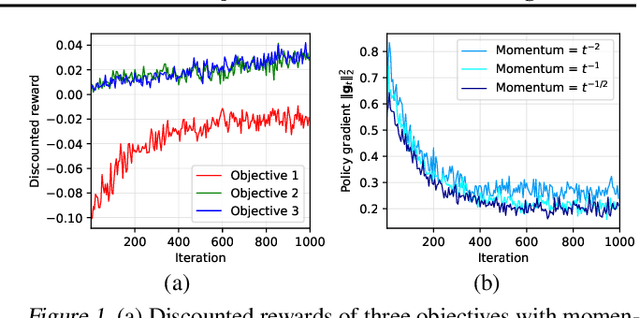


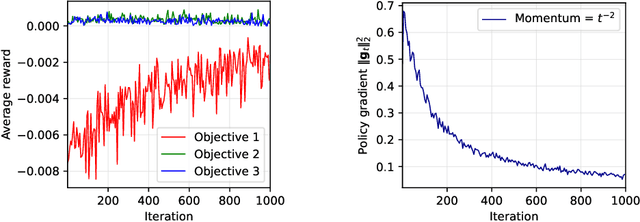
Abstract:Reinforcement learning with multiple, potentially conflicting objectives is pervasive in real-world applications, while this problem remains theoretically under-explored. This paper tackles the multi-objective reinforcement learning (MORL) problem and introduces an innovative actor-critic algorithm named MOAC which finds a policy by iteratively making trade-offs among conflicting reward signals. Notably, we provide the first analysis of finite-time Pareto-stationary convergence and corresponding sample complexity in both discounted and average reward settings. Our approach has two salient features: (a) MOAC mitigates the cumulative estimation bias resulting from finding an optimal common gradient descent direction out of stochastic samples. This enables provable convergence rate and sample complexity guarantees independent of the number of objectives; (b) With proper momentum coefficient, MOAC initializes the weights of individual policy gradients using samples from the environment, instead of manual initialization. This enhances the practicality and robustness of our algorithm. Finally, experiments conducted on a real-world dataset validate the effectiveness of our proposed method.
 Add to Chrome
Add to Chrome Add to Firefox
Add to Firefox Add to Edge
Add to Edge